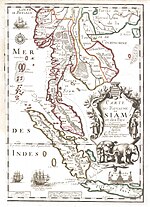
Back تاريخ تايلاند Arabic Historia de Tailandia AST Таиланд тарихы Bashkir থাইল্যান্ডের ইতিহাস Bengali/Bangla Història de Tailàndia Catalan مێژووی تایلەند CKB Dějiny Thajska Czech Thailands historie Danish Geschichte Thailands German Historia de Tailandia Spanish
This article has multiple issues. Please help improve it or discuss these issues on the talk page. (Learn how and when to remove these messages)
|
| History of Thailand |
|---|
 |
|
|

The word Siam (Thai: สยาม RTGS: Sayam) may have originated from Pali (suvaṇṇabhūmi, "land of gold"), Sanskrit श्याम (śyāma, "dark"), or Mon ရာမည (rhmañña, "stranger"), with likely the same root as Shan and Ahom. Xianluo (Chinese: 暹羅) was the Chinese name for the Ayutthaya Kingdom, merged from Suphannaphum city-state, centered in modern-day Suphan Buri; and Lavo city-state, centered in modern-day Lop Buri. To the Thai, the name of their country has mostly been Mueang Thai.[1]
The country's designation as Siam by Westerners likely came from the Portuguese. Portuguese chronicles noted that Borommatrailokkanat, king of Ayutthaya, sent an expedition to the Malacca Sultanate, at the southern tip of the Malay Peninsula, in 1455. Following their conquest of Malacca in 1511, the Portuguese sent a diplomatic mission to Ayutthaya. A century later, on 15 August 1612, The Globe, an East India Company merchantman bearing a letter from King James I, arrived in "the Road of Syam".[2] "By the end of the 19th century, Siam had become so enshrined in geographical nomenclature that it was believed that by this name and no other would it continue to be known and styled."[3]
The Thai established their states: Ngoenyang, the Sukhothai Kingdom, the Kingdom of Chiang Mai, Lan Na, and the Ayutthaya Kingdom. In the 19th and early 20th centuries, only Thailand survived the European colonial threat in Southeast Asia due to centralizing reforms enacted by King Chulalongkorn, and because the French and the British decided to maintain it as a neutral territory to avoid conflicts between their colonies. After the end of absolute monarchy in 1932, Thailand endured sixty years of almost permanent military rule before the establishment of a democratically elected government.
- ^ Campos 1941, p. 119
- ^ Wright & Breakspear 1908, p. 18
- ^ Wright & Breakspear 1908, p. 16